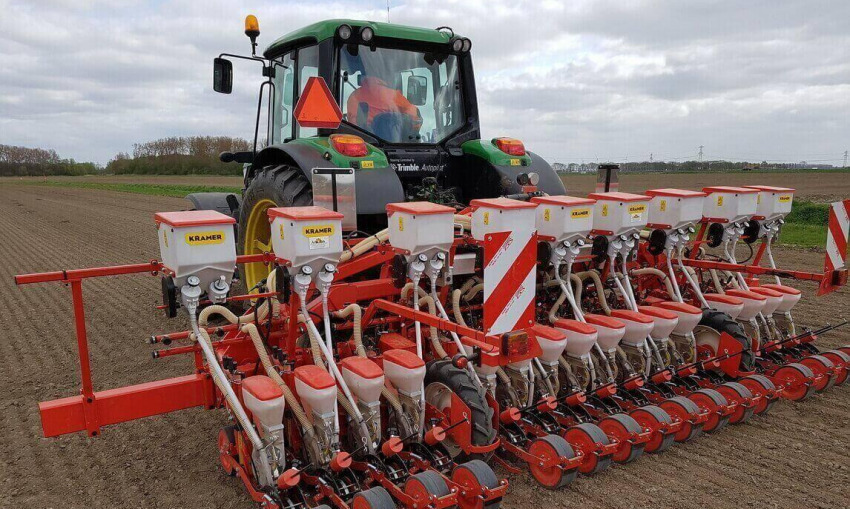
How does precision farming work?
Thanks to the technological and digital innovations obtained in the last 10 years, a real revolution is taking place in the way of doing farming.
Whereas previously the sowing and fertilisation processes took place in the traditional way, ignoring the qualitative and topical characteristics of the field, today farmers can count on sophisticated systems that not only improve the yield of the fields but also significantly reduce the quantity of products used and the pollution due to the excessive use of phytosanitary.
The main components of a precision farming system include:
- A field map indicating the quantities of product to be distributed according to the position of the machine (also in the same field, there can be different soil types and yields). The map, called prescription map, is created by agronomists, using their experience and data collected from:
- Crop yield during previous harvests;
- Mapping of the physical and chemical characteristics of the soil (using satellite photos or photos taken by multi-spectral cameras using drones);
- Measures obtained by soil sampling activities.
- A global positioning system, such as GPS, able to provide the position of the agricultural machine in the field;
- A control unit able to correlate the data on the map and the position of the machine in order to generate the command for the distribution system called target rate. Typically, to perform these operations, ISOBUS systems are used. ISOBUS is a standard that guarantees interoperability between tractors and tools from different constructors;
- The presence of actuators, connected to the mechanical systems, able to distribute the quantity of product in an adjustable way.
What are the components that can interact in precision farming?
In addition to the main components mentioned previously, fall within the scope of the instruments of precision farming:
- Sensors that can give real-time information about the status of the field. For example, weather or humidity sensors that allow for planning activities based on soil conditions, but also force sensors based on multi-spectral cameras installed directly on the tractor that allow providing commands for the distribution system in real-time;
- Autonomous driving, a system which, through global positioning systems and hydraulic/electric drives, allows the operator to drive the tractor on predefined routes in the field (for example, on parallel lines at fixed distances one from the other);
- Farm Management Information System (FMIS), valuable for collecting data and using them to make the right decisions, documenting works and keeping everything under control (also to comply with legal obligations, especially regarding the use and distribution of phytosanitary).
What type of equipment is suitable for a precision farming system?
The entire agricultural supply chain benefits from the concepts of precision farming; it is clear that all operations where products are distributed, typically expensive (such as seeds) or potentially polluting (such as fertilisers or phytosanitary), are those activities that may be more interested in the topic of precision farming.
Among the equipment, we can mention:
- Sprayers, to avoid the overuse of products;
- Precision, pneumatic or cereal seeders (in the case of seeding, for example, if the agronomist's data shows that there are areas on his field with a higher yield, he will increase the seed population in that area to get the most of the field's potential);
- Fertiliser spreaders;
- Transplanters.
Those listed above are only a partial list of the implements on which the return on investment takes on an interesting value.
How can traditional agricultural equipment be transformed into precision equipment?
In addition to buying new equipment fitted with precision farming systems, the farmer can modernise his traditional machines by adding the components mentioned above and making a retrofit.
To give a practical example: if you have a pneumatic seed drill, you can eliminate the chain drive and transmission wheel, typically replacing them with an electric motor, connected directly to the volumetric distributor and controlled by an ISOBUS electronic control unit connected to the tractor (in this way, the machine, instructed by information extracted from the prescription map, is able to distribute the product in variable doses).
In the above scheme, in the transformation process from traditional agricultural equipment to equipment 4.0, ROJ Agri-Motion provides, in addition to its experience in the sector, the implementation part, giving its customers the electric motors and the wiring for the distribution of the power.
During the years, ROJ Agri-Motion has closed strategic partnerships with some of the primary ISOBUS control unit constructors, with whom it now has an established supply relationship. These synergies have allowed better communication between its motors and these control systems.
What are the figures for precision farming?
A study carried on by the Digital Innovation Observatory of the School of Management of the Polytechnic University of Milan indicated that the Agriculture 4.0 market, in Italy, in 2020 would be around €540 million (approximately 4% of the world market, bringing the estimated global market value at €10 billion), growing by 20% compared to the previous year.
Then, from an economic point of view, there is a general consent in affirming that precision farming brings savings of 10-15% on the material (just by distributing the product where it is needed and avoiding overlaps) and 15% on diesel (savings obtained thanks to autonomous driving, which makes it possible to optimise routes in the field).
Therefore, there is no doubt that this is the way for the future for agriculture, and ROJ Agri-Motion can be the ideal partner to walk together. Contact us for more information!
To learn more precisely what precision agriculture is, we suggest reading the article Precision agriculture: from satellite to earth

